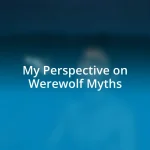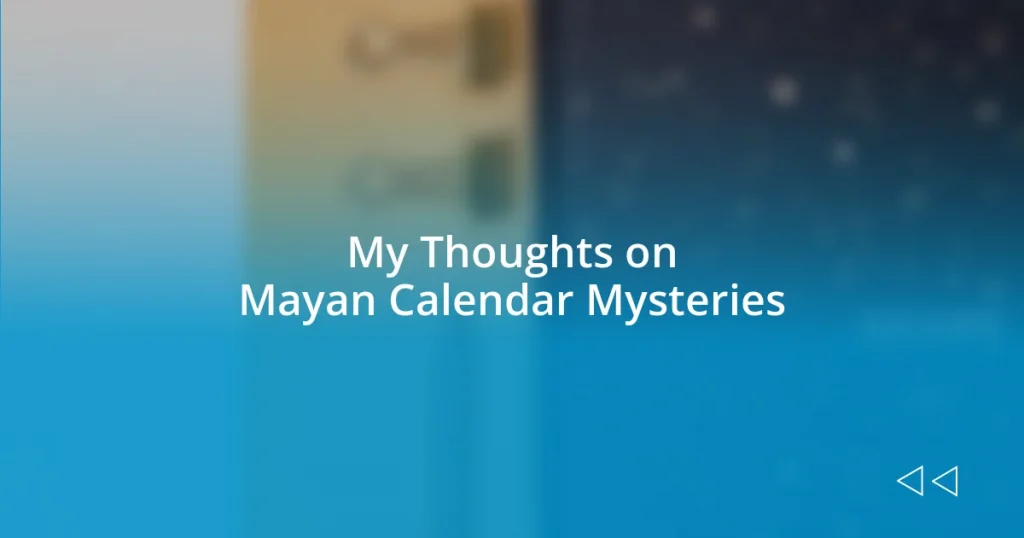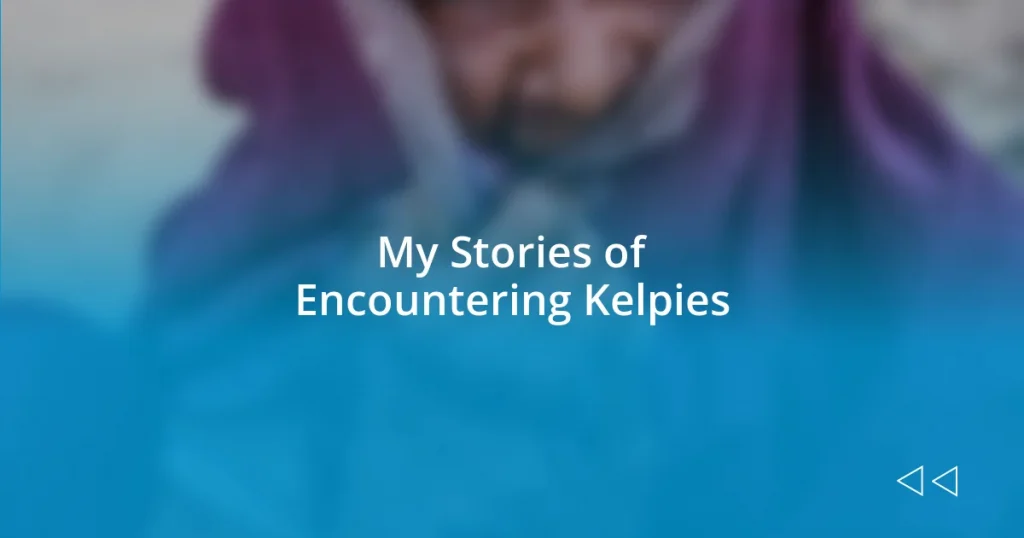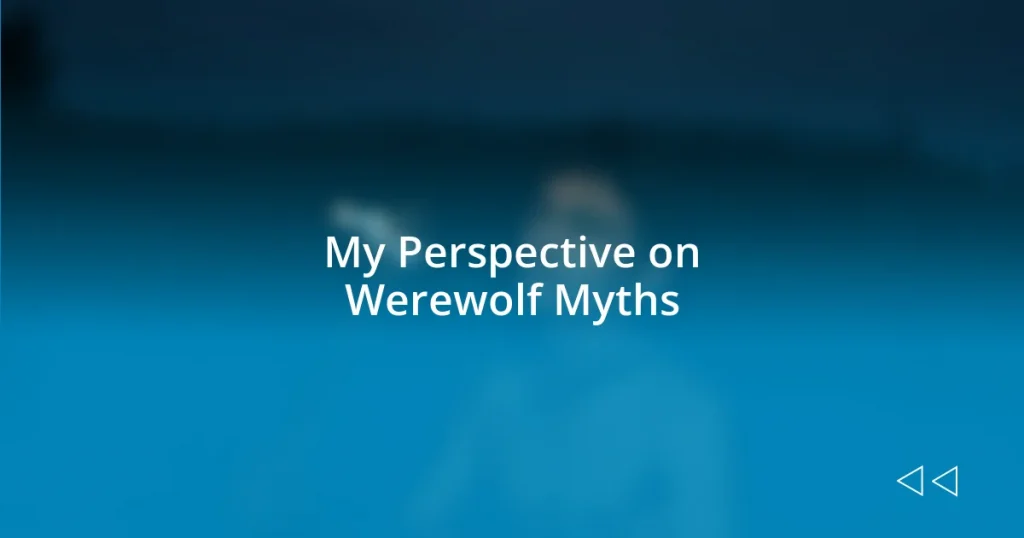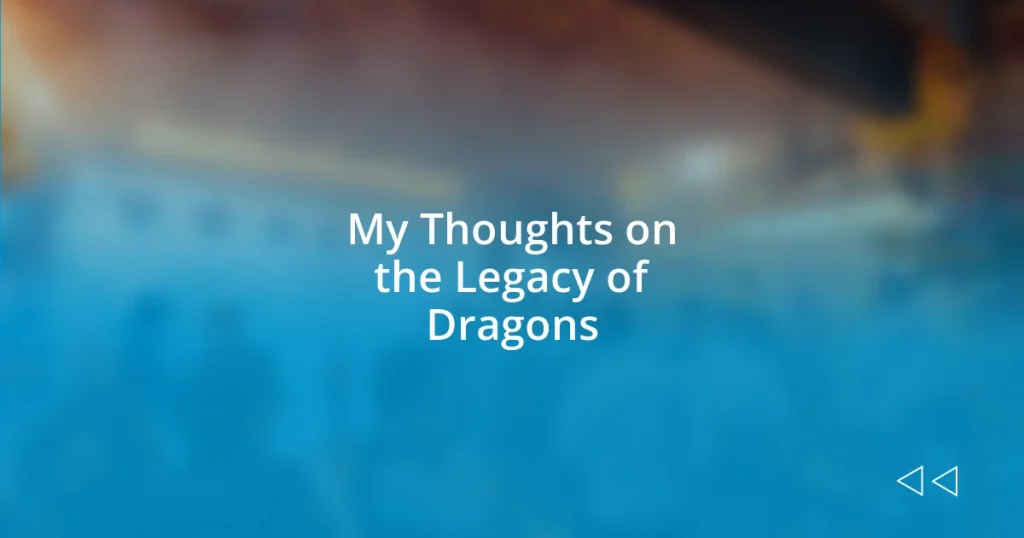Key takeaways:
- The Mayan calendar is a complex system reflecting the civilization’s deep connection to nature and spirituality, organizing time into cycles like Tzolk’in and Haab’ that guide agricultural and ceremonial practices.
- Maya beliefs emphasize duality and mythology, illustrating their understanding of existence and the interconnectedness of life, death, and natural cycles, which have modern parallels in current narratives and spirituality.
- Exploring the Mayan calendar enhances modern life by inspiring individuals to align with natural rhythms, fostering communal bonds, and reshaping perspectives on time, transformation, and personal growth.

Introduction to Mayan Calendar
The Mayan calendar is a fascinating system that goes far beyond simply marking the passage of time. It’s a reflection of the Mayans’ deep connection to the cosmos and their understanding of cycles in nature. Every time I think about how this ancient civilization tied their daily lives to celestial movements, I feel a sense of awe.
What truly intrigued me when I first learned about the Mayan calendar was its complexity. The way they organized time into various cycles, such as the Tzolk’in (a 260-day ritual calendar) and the Haab’ (a 365-day solar calendar), feels almost like an art form. Can you imagine the precision and thought that went into creating such a system? It makes me appreciate the intelligence of the Mayan people even more.
Moreover, the calendar wasn’t just a method of tracking time; it held significant religious and cultural importance. Each day was imbued with its own unique energy and meaning. I recall my excitement during a lecture where we discussed how the Mayans predicted events, from agricultural cycles to even political changes, based on their understanding of this intricate system. It really made me ponder how much we can learn from ancient cultures and their perspectives on life.
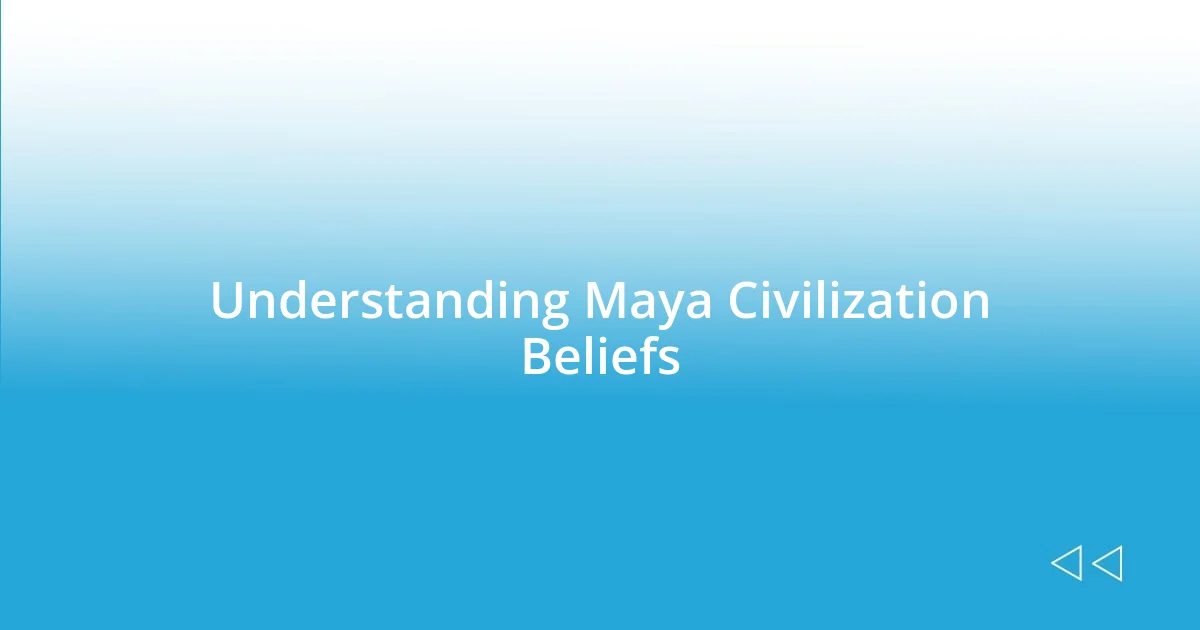
Understanding Maya Civilization Beliefs
The Maya civilization was steeped in beliefs that profoundly influenced their way of life. I remember feeling fascinated as I learned about how for the Mayans, gods were not distant figures but integral to daily experiences. They engaged in rituals and ceremonies, believing that appeasing these deities would ensure fertility, health, and prosperity. This connection to spirituality and the earth was a recurring theme in their art and architecture, often designed to reflect their reverence for nature.
One striking aspect of Maya beliefs is the presence of duality in their cosmology. I find it interesting how they viewed the interplay between life and death, day and night, and good and evil. This dual nature helped shape their understanding of existence, creating an intricate balance within their society. In many ways, learning about this has deepened my appreciation for how ancient peoples sought to make sense of the world around them, much like we do today, albeit through different lenses.
Furthermore, the Mayans had an elaborate mythology that explained their origins and the cycles of the cosmos. As I delved into their tales, I couldn’t help but draw connections to modern narratives that echo similar themes. The hero’s journey, transformation, and the quest for knowledge—it made me reflect on how storytelling serves as a universal thread connecting us through time. Isn’t it captivating to realize that despite the centuries that separate us, the human experience remains profoundly relatable?
| Maya Beliefs | Modern Comparisons |
|---|---|
| Gods as integral to life | Spirituality in daily routines |
| Duality in cosmology | Balance in modern beliefs |
| Elaborate mythology | Modern storytelling |
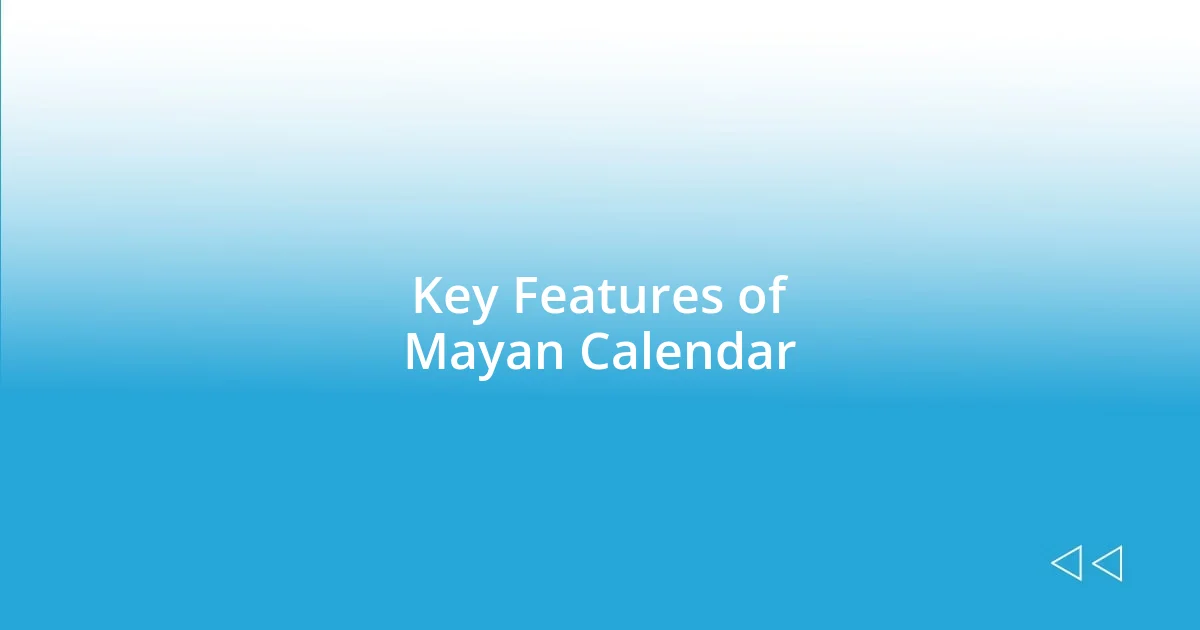
Key Features of Mayan Calendar
The Mayan calendar features a unique structure that fascinates me each time I explore its intricacies. For instance, the combination of the Tzolk’in and the Haab’ not only organized time but also tied it to the agricultural and ceremonial rhythms of life. I vividly remember tracing these cycles with a group of friends during a cultural study session; each turn of a day felt like we were dancing in sync with the universe itself.
Key Features of the Mayan Calendar include:
- Tzolk’in: A 260-day ritual calendar combining 20 day names with 13 numbers, significant in religious ceremonies.
- Haab’: The 365-day solar calendar reflecting the seasons, used for agricultural planning.
- Calendar Round: A 52-year cycle where the Tzolk’in and Haab’ rotate together, marking a significant completion of time.
- Long Count: A system to track longer periods, often used to record historical events.
- Cosmic and Spiritual Connections: Each day held specific meanings tied to astronomical occurrences, deeply influencing Mayan culture and practices.
When I learned how these calendars intersected, it struck me that they encapsulated a philosophy that is almost poetic. Each period told a story, marking important moments like planting seasons or festivals. I remember feeling a shiver of excitement when realizing that my own life has cycles too, making the ancient calendar more relatable than I ever imagined.
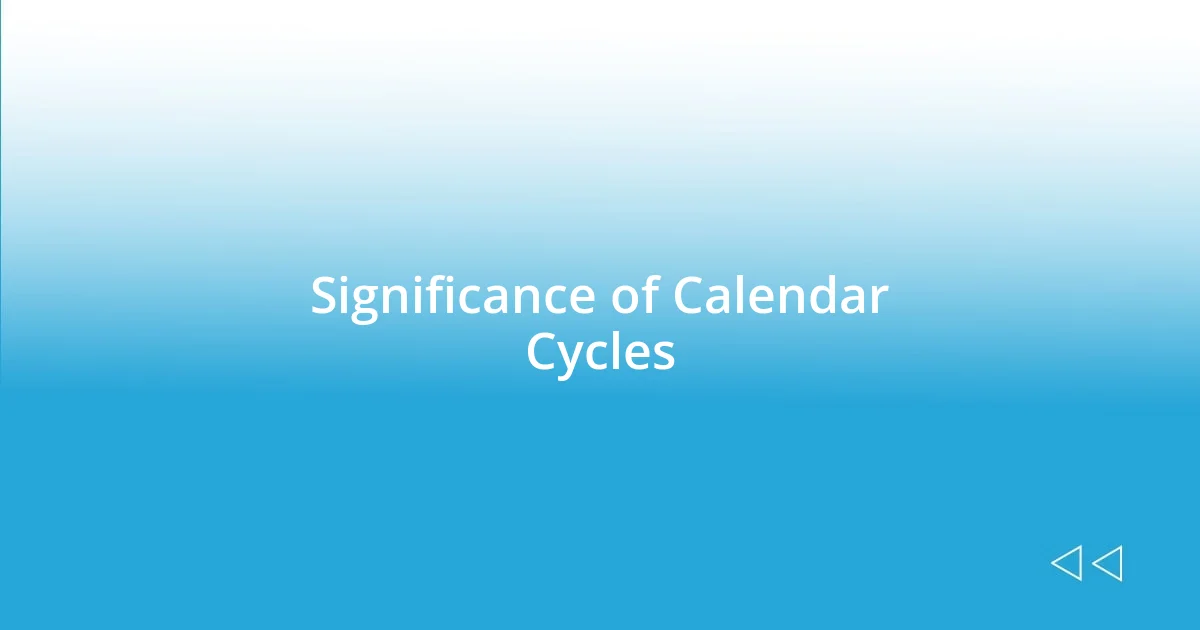
Significance of Calendar Cycles
Calendar cycles in the Maya civilization were more than just a way to measure time; they were a vital expression of their worldview. Each cycle held significance, linking the rhythms of the natural world to their spiritual and social lives. I can recall a time when I was studying the Tzolk’in calendar and felt a strange sense of connection to the seasonal changes it represented. Doesn’t it make you think about how our modern lives often overlook these natural cycles?
The interplay between the Tzolk’in and Haab’ calendars demonstrates the Maya’s deep understanding of harmony. They had an instinctual grasp of how time interlaces with agriculture and ceremonies, a reminder that these cycles aren’t just historical but reflect our own lives. When I consider the transition of seasons today, I often feel a heightened awareness of how these changes influence my own routines—planting, harvesting, celebrating.
In exploring these calendar cycles, I reflect on the significance of the Calendar Round and Long Count. These systems not only marked years but created a cultural story that framed the Maya’s identity over centuries. Once, I participated in a workshop where we aligned our personal goals with the calendar’s rhythm. It was a revelation to see how acknowledging these cycles could help us connect not only with history but also with our personal journeys. Isn’t it fascinating how ancient wisdom can still offer guidance in our modern lives?
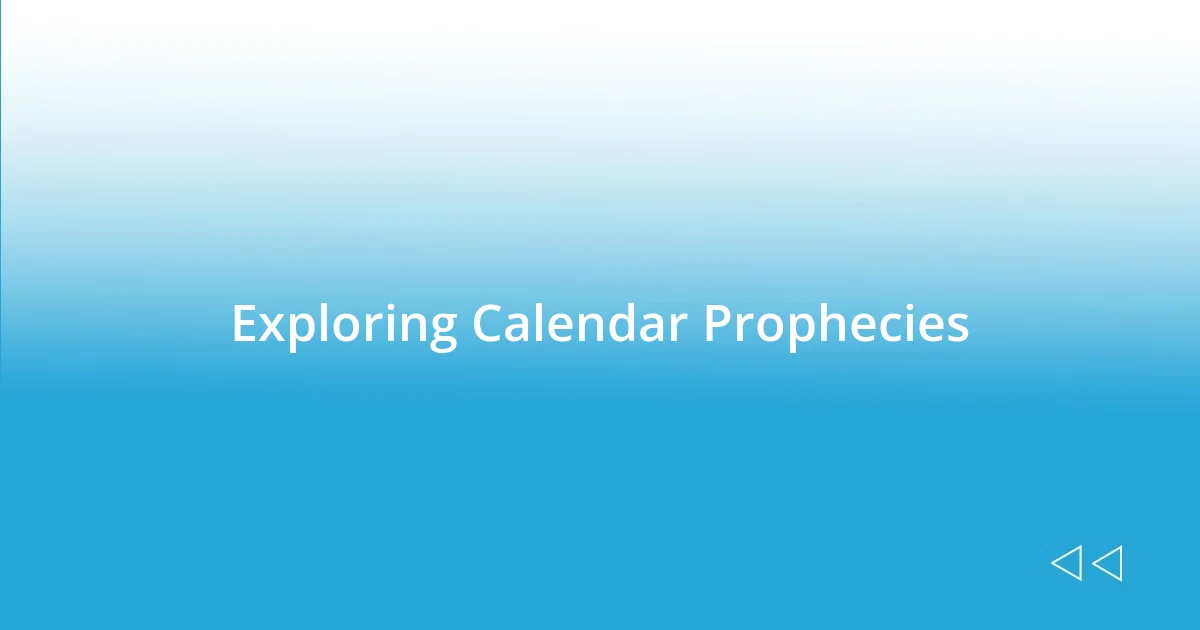
Exploring Calendar Prophecies
Delving into calendar prophecies reveals a captivating layer of Mayan cosmology. The intricacy of their predictions reflects a profound connection to the movements of celestial bodies. I remember sitting under a starlit sky while discussing how the Mayans aligned their prophecies with the stars above—a humbling moment that made me appreciate how our ancestors tapped into the cosmos for guidance. Could there be a better reminder of our place in the universe?
One striking aspect is the notion that the Mayans believed certain dates were imbued with powerful energies. For instance, the conjunctions of planets or the solstices held particular significance in shaping their expectations for the future. As I explored this during a trip to an ancient site, I felt an electrifying sense of possibility—what if we, too, could harness the power of timing in our own lives? I reflected on how being mindful of significant dates can influence our choices, prompting me to connect more deeply with moments that matter.
Moreover, the interplay of prophecy and time in Mayan culture forces us to ponder the nature of fate and free will. When I first learned about how the Long Count system predicted major cycles of rebirth, I found myself questioning my own beliefs about destiny. Do we have control over our paths, or are we simply players in a larger cosmic theater? I believe the Mayans offer us a profound lesson: while we may not dictate the tides of time, we can certainly choose how we navigate through them.
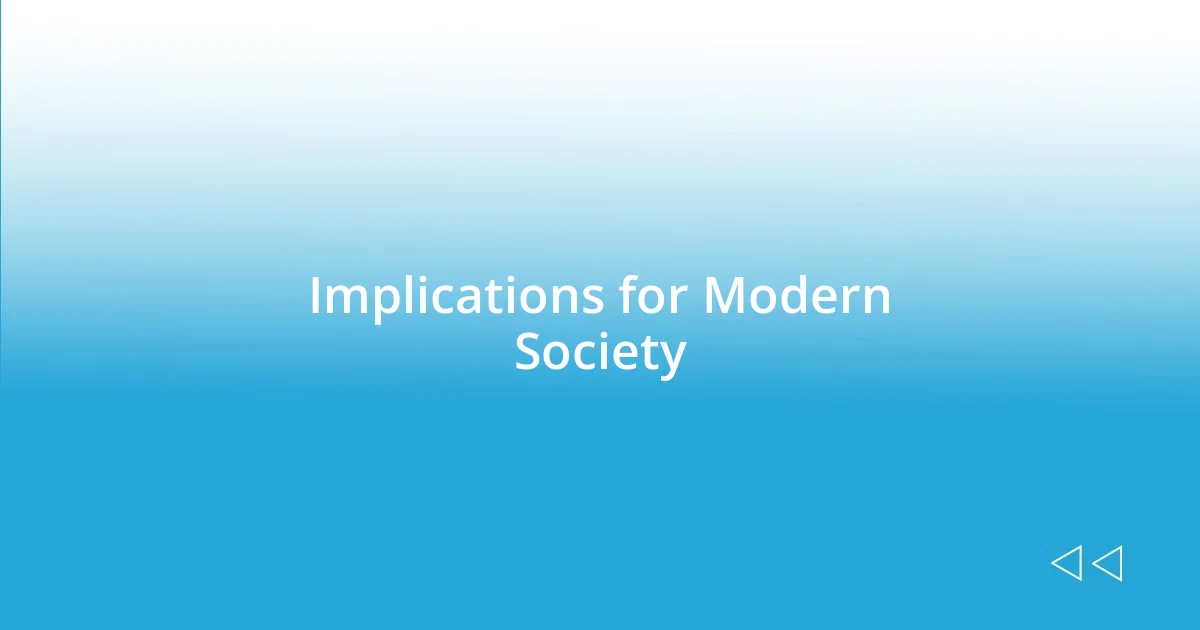
Implications for Modern Society
Understanding the implications of the Mayan calendar for modern society might stir a sense of nostalgia for how we connect to time. When I first started applying the principles of cyclical time in my life, I shifted from a linear approach to a more holistic view. Isn’t it interesting to consider how adopting a rhythm that aligns with natural cycles could change how we approach our everyday tasks and celebrations?
This perspective can encourage us to embrace patience and timing in a world that often demands instant results. I remember a particularly busy period when I neglected the seasons, only to feel drained and out of sync. Reflecting on the Mayans’ deep respect for planting and harvesting times, it occurred to me that perhaps taking a step back to breathe and acknowledge these cycles could actually enhance productivity and well-being. How often do we give ourselves permission to pause?
Furthermore, the lessons embedded in the Mayan calendar can inspire communal bonds. In our fast-paced lives, it’s easy to forget how powerful it can be to come together for seasonal festivals or community events. I’ve found that participating in local traditions rooted in these cycles has not only strengthened my connection with others but also deepened my appreciation for the passage of time. Are we missing opportunities to celebrate and create meaning in our lives when we sideline these ancient practices? Embracing these implications could be transformative for both individuals and society as a whole.
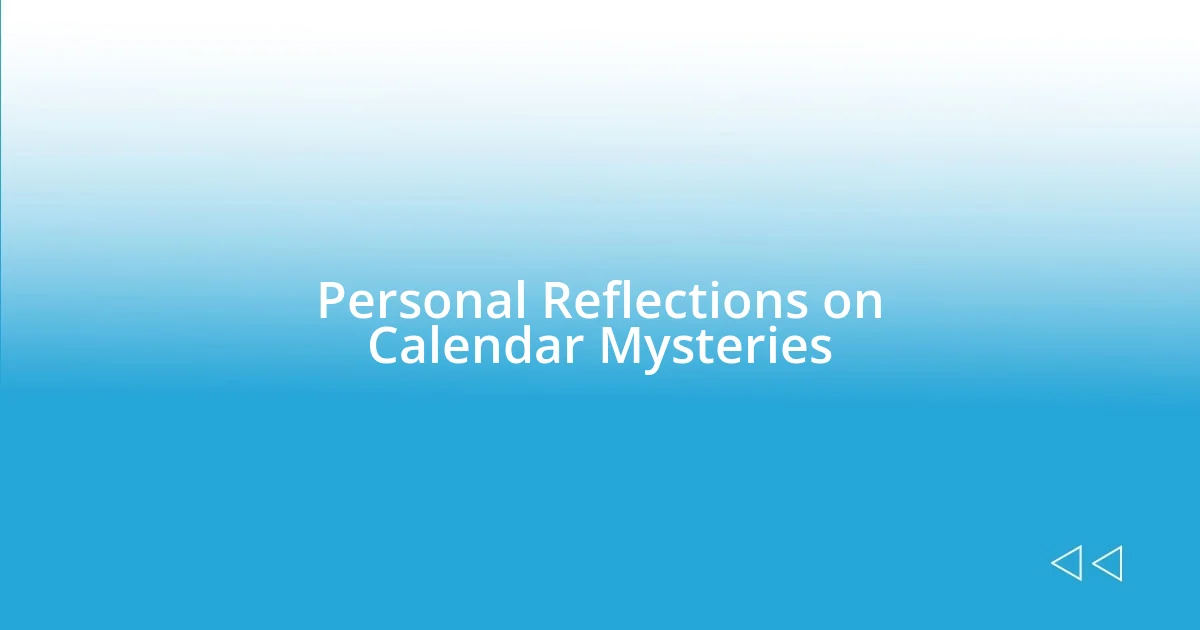
Personal Reflections on Calendar Mysteries
Reflecting on the mysteries of the Mayan calendar draws me into a realm where time feels almost sacred. I vividly recall a sunrise hike I took at Tikal, where the first rays illuminated ancient temples. Standing there, surrounded by the quiet hum of nature, I couldn’t help but feel the weight of history and how these structures were built to honor time itself. It made me ponder: how often do we ignore the profound rhythms that dictate our lives?
There’s something mesmerizing about the idea that specific dates resonate with cosmic energies, isn’t there? I remember celebrating my birthday this past year on a date that coincided with a full moon. It felt as if the universe was sending me a gentle nudge, inviting me to set intentions for the coming year. This interplay of personal milestones with celestial events illuminates the idea that our lives are woven into a larger tapestry. How might we align our personal journeys with these cosmic cycles to enrich our experiences?
Exploring the concept of cyclical time has reshaped my understanding of life’s ebb and flow. Once, in a frustrating season of my career, I felt trapped in a linear mindset, counting down the days until I could escape. Then came a moment of realization during a meditation session when I embraced the idea that every ending is merely a new beginning. This revelation, deeply inspired by the Mayan perspective on time, helped me recognize that I could cultivate patience and trust in my journey. Isn’t it fascinating how a shift in perception can lead us to view our challenges not as obstacles but as essential parts of our growth?


